Fukuoka Food Map: 35 Restaurants, Cafes, and Bars in 2024

Discover the essence of Fukuoka, Kyushu's culinary gem. Delight in tonkotsu ramen, motsu nabe (beef-intestines hot pot), and Mizutaki chicken pot. Immerse yourself in street food culture and trendy cafes with a modern twist. This guide offers a flavor-packed exploration of Fukuoka's gastronomy.
Fukuoka Food Guide
1. Fukuoka Specialty Hot Pot
2. Fukuoka Udon Noodles with a Soft and Tender Texture
3. Tonkotsu Ramen: Leading the Ramen Trend
4. Food Stalls and Fukuoka Night Market Vibes
5. Izakaya Bars in Fukuoka
6. Desserts and Coffee Shops
7. Take-Out Food in Fukuoka
8. Unique Bars: Sample Appetizers and Interact with Travelers
This article introduces the cuisine of Fukuoka. We recommend referring to the articles below for a deeper understanding of dining, entertainment, and accommodations around Hakata Station!
Read also
Heartwarming Fukuoka Specialty Hot Pot
Fukuoka locals also enjoy hot pot dishes, with Mizutaki Chicken Hot Pot and Beef Intestine Hot Pot being particularly popular among residents. Mizutaki chicken hot pot is known for its light chicken broth, offering a refreshing and not overly heavy flavor.
As for beef intestine hot pot (motsu nabe), the taste varies on the style of each specialty store, featuring broths in flavors like original, miso, soy sauce. All provide rich and bold flavors regardless of the broth you choose.
Mizutaki Chicken Hot Pot: Hakata Hanamidori

Fukuoka locals recommend trying this hot pot classic: Mizutaki chicken hot pot. Several izakayas in Fukuoka City offer this dish. But for the most authentic Mizutaki chicken hot pot experience, a visit to Hakata Hanamidori is a must. With its refined broth paired with the freshest chicken, its refreshing taste will surely redefine your hot pot expectations.
Beef Intestine Hot Pot: Motsunabe Ikkei

Motsunabe Ikkei is a popular restaurant in Fukuoka known for its rich and authentic beef intestine hot pot.
During lunch, they offer a choice between grilled fish meal sets or beef intestine hot pot sets, perfect for solo or multiple travelers.
In the evening, it transforms into an izakaya specializing in beef intestine hot pot. What sets this place apart from others is that they sear the beef intestine before cooking!

In the world of beef intestine hot pots dominated by rich and hearty flavors, Motsu Kou, which boldly advocates for a "refreshing and not heavy" taste, stands out in Fukuoka's competitive beef intestine battleground, tantalizing the taste buds of many diners.
While the ingredients and broth in the hot pot are light and fresh, the highlight of this restaurant is the finishing touch.
As the hot pot nears completion, the staff will add *sturdy noodles and a generous amount of sesame into the remaining broth for a simple preparation. Once cooked, the rich aroma of sesame permeates the air, stimulating your senses once again.
*Sturdy noodles: Similar to the oil noodles used in Taiwan.
Fukuoka Udon Noodles with a Tender Texture
The uniqueness of Fukuoka udon noodles lies in the softness of the noodles and the ingredients used. In contrast to the renowned "chewy noodles" of Sanuki Udon from Kagawa Prefecture, Fukuoka's udon noodles tend to be softer.
It is said that the composition and ratio of udon flour were intentionally adjusted to aid in easier digestion. Additionally, Fukuoka udon noodles are typically topped with crispy burdock tempura and round fish cakes (maruten).
Makino Udon Noodles (Makino Udon)

Photo by toshifukuoka
The characteristic of Makino Udon Noodles (Japanese) is its smooth and palatable broth. What sets it apart is the feeling of never being able to finish it, no matter how much you eat. Yes! You read that correctly!
This is because the restaurant provides a teapot filled with udon noodle broth, allowing customers to freely refill the broth. The udon noodles gradually lengthen, expand, and soften with each refill, often creating the illusion of being never-ending.
Hakata Akachokobe

Hakata Akachokobe is located near the renowned Kushida Shrine in Fukuoka, an area rich in historical charm. Establishments that thrive in this culturally infused region naturally excel in excellent taste.
What sets this restaurant apart is the use of a water kettle to enjoy udon noodles.
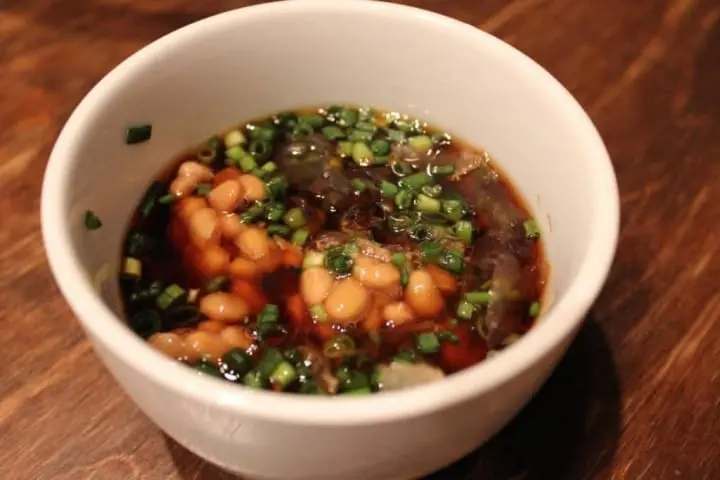
Furthermore, the distinct flavor is found in the sauce used with the udon noodles, which surprisingly includes natto! Despite seeming like an odd combination, this unexpected blend orchestrates a chorus of satisfied customers eagerly chewing bite after bite.
Inaba Udon Noodles (Inaba Udon)

Photo by Youhei Nitta
Inaba Udon Noodles (Japanese) places a strong emphasis on noodle craftsmanship. In addition to hand-rolled noodles, they insist on using natural ingredients such as rausu kombu kelp from Hokkaido, dried small fish from Goto City in Nagasaki Prefecture, and soy sauce from Hita City in Oita Prefecture to create their broth.
The broth presents a refreshing taste in summer and a rich flavor in winter. Adjusting the broth's flavor to match the season's temperature and climate is a key part of their cooking process.
Suke Udon Noodles (Suke-san Udon)

Photo by toshifukuoka
Suke Udon Noodles originated in Kitakyushu City, Fukuoka Prefecture, and is a beloved udon noodle chain among locals.
The signature dish at Suke Udon Noodles is the "Burdock Udon Noodles," which features slender burdock roots. The crispy texture of the freshly-fried burdock paired with the fragrant aroma of burdock oil drizzled over the udon noodles will undoubtedly tempt you to add another burdock for extra savory satisfaction.

Photo by toshifukuoka
In Fukuoka Prefecture, Suke Udon Noodle restaurants are typically located in suburban areas away from the city center. Therefore, those eager to taste these delights should rent a car or take local buses to reach these establishments.
Check Fukuoka Accommodation Deals and Availability
Tonkotsu Ramen: Leading the Ramen Trend
While it's said that ramen originated in China, it has evolved into various flavors and styles, such as soy sauce, salt, miso, and tonkotsu (pork bone) in Japan. Moreover, these flavors are constantly growing, evolving, and thriving.
Among these ramen flavors, tonkotsu ramen has been particularly popular in Japan in recent years. This tonkotsu ramen trend can be felt through the 2016 Japan Chain Noodle Shop National Grand Prix food competition, where the chain with the most national votes came from Fukuoka, namely Ichiran Ramen.
The characteristic of Fukuoka's tonkotsu ramen is the extremely thin noodles and white, cloudy pork bone broth. We'll now introduce some authentic tonkotsu ramen shops in Fukuoka that even locals passionately follow!
Hakata Junjo Ramen ShinShin
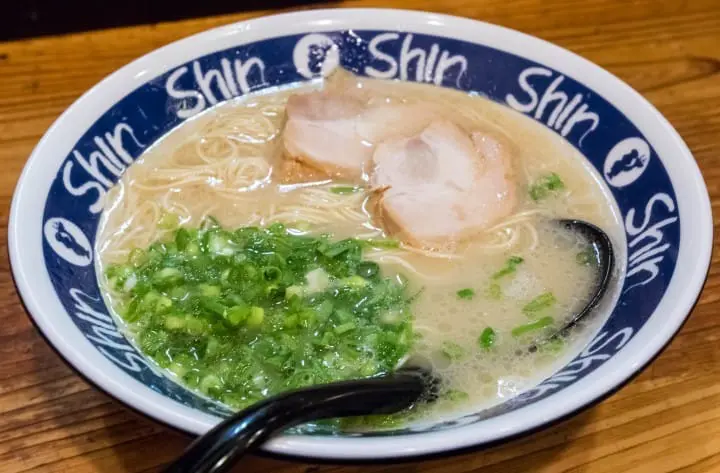
Photo by kazunorikamiya
In Fukuoka Prefecture's competitive tonkotsu ramen arena, ShinShin Ramen (Japanese) is a must-visit local favorite, even if it means waiting in long queues. This ramen shop prides itself on serving tonkotsu ramen, which makes you want to finish every drop of the broth.
This is because most tonkotsu ramen tends to be too rich, leading diners to abandon the carefully prepared broth halfway through the meal. To address this, ShinShin carefully selects domestically sourced pork and chicken bones from Saga Prefecture to create a delicious broth without unwanted flavors.
Cannon Ramen

Cannon Ramen (Japanese) originated in the Kurume area of Fukuoka Prefecture, initially founded by a couple at a roadside stall. The uniqueness of Cannon Ramen lies in its distinct broth-making process, where the broth made in a day is not entirely finished.
The shop retains some broth to mix with freshly cooked broth the next day. In the ramen world, this technique of mixing "old broth" and "new broth" is said to be quite special. This creates a unique and rich "traditional flavor" tonkotsu ramen.
Ikkousha

Photo by Ryosuke Hosoi
Ikkousha (Japanese) was founded in 2004. Despite its relatively short history in noodle-making, it showcases the founder's dedication and persistence toward tonkotsu ramen.
During broth preparation, they insist on using two *hagoita pots to simmer the pork bones into a foamy broth to create a rich and creamy texture. They collaborate with a local noodle factory in Fukuoka to make noodles that absorb the tonkotsu broth while maintaining a firm texture.
Additionally, for the chashu (sliced roast pork) in their ramen, they choose evenly marbled pork shoulder, marinate it with the restaurant's traditional sauce, and stew it to create a large, thick-cut chashu that enhances the overall ramen experience.
*Hagoita: Large pot with a handle and lid used for simmering broth.
Original Akanoren Setchan Ramen Main Store

Photo by Cheng-en Cheng
Original Akanoren Setchan Ramen Main Store is a traditional tonkotsu ramen shop founded in 1946.
Its ability to stand out in the fiercely competitive tonkotsu ramen arena for over 70 years speaks volumes about the consistent and delicious flavors it has maintained since its establishment.

Photo by Cheng-en Cheng
Although it features a tonkotsu broth, the high proportion of soy sauce adds a unique flavor that is different from other ramen shops. What sets this place apart is the value-for-money ramen set that is a favorite among foodies.
The Ramen Set includes tonkotsu ramen, fried rice, and 3 pan-fried dumplings for only 750 Japanese yen! In an era where a bowl of ramen easily costs 700 to 800 Japanese yen, offering such a value-pack set is truly remarkable.
Mengekijo Gen-ei

Mengekijo Gen-ei is nestled in the alleyways near Nishitetsu Yakuin Station in Fukuoka. The interior is designed like a theater with tiered seating, allowing patrons to watch the noodle-making process from any angle.

The Gen-ei Style Ramen is the restaurant's most popular and signature ramen. In addition to enhancing the overall flavor with ingredients like shredded scallions and wood ear mushrooms, it includes two slices of charred pork to infuse a subtle smoky flavor into the broth.
The slightly translucent broth might make you wonder, "Is this really tonkotsu broth?" But with just a sip, the aroma of pork bone instantly fills your mouth, offering a rich yet not overwhelming taste that is truly delightful.
Ganso Nagahamaya

Ganso Nagahamaya (Japanese) only offers tonkotsu ramen on its menu, with additional options for extra noodles, meat, and alcohol. T
he simple menu reflects the restaurant's dedication and confidence in its ramen-making. Located near the Fukuoka Fish Market, the establishment originally opened early to serve hot breakfast to market workers. This tradition continues today but caters to a diverse crowd seeking delicious ramen at all hours.

The clear and lightly savory broth is the highlight of Nagahamaya. For those seeking a stronger taste, white teapots filled with sauce on the tables allow diners to adjust the broth's intensity to their liking.
The rustic wooden benches, oversized teapots, and simple tea bowls in the restaurant reflect the nostalgic charm of this ramen shop that has been in business for over 50 years.
Hakata Issou

Hakata Issou was co-founded by the Yamada brothers, both under 30 years old.
Inspired by a ramen feature on TV during high school, the elder Yamada brother harbored a dream to open his own ramen shop. His passion for ramen profoundly influenced his younger brother. After years of individual ramen apprenticeships, they finally established Hakata Issou Ramen in 2012.

At Issou Ramen, their tonkotsu ramen not only boasts a rich flavor but also releases an irresistible pork bone aroma that often piques the curiosity of passersby, resulting in long queues.
The owners insist on using domestically sourced young pig bones and undergo a lengthy high-temperature stewing process to emulsify the pork bones into a creamy state. Ramen enthusiasts even refer to the rich fat bubbles that appear on the surface of the broth as "Tonkotsu Cappuccino."
Ichiran

When it comes to tonkotsu ramen, it's essential to mention the champion ramen that has been popular worldwide for several years: Ichiran Ramen.
In the ramen kingdom of Japan, establishing a foothold in the competitive tonkotsu ramen arena is no easy feat—let alone dominating the entire ramen scene. To achieve such recognition, every element that influences ramen quality, from broth, noodles, and toppings to service, must meet top-notch standards.
While in Fukuoka, visiting the Tenjin branch to taste their tonkotsu ramen served in square-shaped bowls is a must-do experience!
Read also
Stroll Through Food Stalls and Experience Fukuoka Night Market Vibes

At night, Fukuoka exudes a nostalgic ambiance and aroma. As dusk falls, numerous food stalls, locally known as yatai, sprout up like mushrooms after the rain, lining the streets of Fukuoka and serving a variety of local delicacies.
Kokinchan

Kokinchan (Japanese) is located near the Tenjin shopping district in Fukuoka. Fukuoka's local dish, yaki-ramen (grilled ramen), is said to have gained fame from this humble food stall.
Due to its convenient location and exquisite cuisine, it is often crowded with eager diners. Those looking for a taste must be prepared to wait at least 30 minutes.

What is yaki-ramen? It is a dish where boiled ramen noodles are stir-fried on an iron plate with a special sauce and tonkotsu broth. It is a dish similar to "fried noodles," but its unique texture and flavor are indescribable.
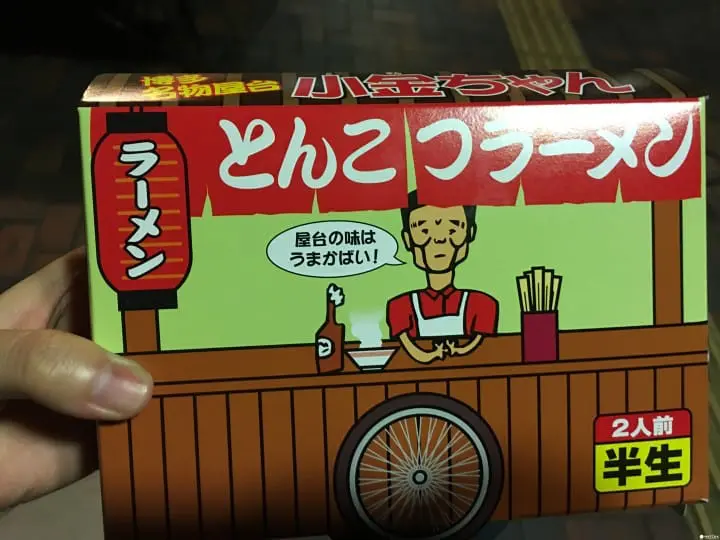
Kokinchan's tonkotsu ramen is so famous and delicious that they now offer to-go ramen products. We highly recommend them as gifts or personal indulgences!
Yatai Okamoto

Photo by Keiichi Yasu
Yatai Okamoto (Japanese) is located near Watanabe Street in Fukuoka, about a 10-minute walk from Tenjin. Besides serving delicious tonkotsu ramen, this food stall is known for its grilled dishes.
This includes Wagyu Sirloin Steak being a favorite among connoisseurs. Since this stall is a bit far from the station, it mainly attracts nearby office workers, making it a great spot to experience authentic food stall vibes.
Satsumaya

Photo by m-louis®
Satsumaya is located near Tenjin Station, making it a convenient choice for those seeking a quick Fukuoka food stall experience without straying too far from the station.
In addition to serving tonkotsu ramen, this establishment offers a rich variety of a la carte dishes such as oden (a type of hot pot) and yakitori. The charcoal-grilled Jidori chicken, miso-fried maruchan sausage, and small fish tempura are trendy among diners.
Hakata Yatai Medetaiya

The impression most people have of food stalls is that they are located outdoors. However, Hakata Yatai Medetaiya goes against the norm by setting up their food stall indoors.

As a shop that prides itself on offering an easy way to enjoy food stall culture and local cuisine, Hakata Yatai Medetaiya allows visitors to observe actual food stall equipment used outdoors and the cooking process.
While most food stalls typically serve tonkotsu ramen, this place offers Kamatama Mentaiko Udon, which is udon noodles mixed with spicy cod roe and a raw egg.

Furthermore, as an indoor food stall, Hakata Yatai Medetaiya boasts more extensive cooking equipment than regular outdoor food stalls. This allows guests to enjoy authentic local dishes (such as beef intestine hot pot) that outdoor stalls might be limited in providing due to equipment constraints.
Versatile Izakaya: Perfect Spot for a Drink
When in Fukuoka and looking to enjoy a good drink, where else can you go besides food stalls? There are actually a variety of unique izakayas and local eateries that would be great choices!
Hakata Fudo

Hakata Fudo is located near Hakata Station's Chikushi Exit, and is one of the popular izakayas among office workers.
Besides offering a wide selection of beverages such as draft beer, sake, shochu, and cocktails, they also serve Fukuoka's signature dishes like beef intestine hot pot, grilled dishes, and pan-fried dumplings. The grilled whole chicken impressed the writer the most among their many specialty dishes!
Jidori Shokudo

In addition to being coined the "Ramen Kingdom," Kyushu is renowned for its "jidori," or free-range locally-raised chickens. They are rich in fat and have excellent texture, making Kyushu a hub for chicken cuisine. Jidori Shokudo offers a great all-you-can-eat deal!

Tender Jidori chicken cooked over a charcoal grill creates a mouthwatering sensation that will make you crave more!
Shifudo (Seafood) Izakaya

Want to taste the freshest seafood for just 500 yen? Look no further than Shifudo Izakaya!
By selecting the "Treasure Chest of the Sea" dish, you can enjoy a seasonal sashimi platter for just one coin. "High cost-performance" and "amazing value for 500 yen" are the only words that come to mind!

In addition to the highly recommended "Treasure Chest of the Sea" platter, the extravagant Tornado-fried Burdock and Bamboo Shoots with Flying Fish is a must-try!
Hakata And Fisheries Isogai Shirasu Whale Hakata Station Store

Photo by toshifukuoka
This seafood lover's haven, Hakata And Fisheries Isogai Shirasu Whale Hakata Station Store, located near Hakata Station's Hakata Exit, is a must-visit establishment.

Photo by toshifukuoka
While their signature dish is the fresh sashimi platter, the most popular item is the fresh sea urchin, priced at only 600 yen!
Read also
Soothing Your Stomach with Sweets and Coffee
In addition to its renowned specialties like ramen, hot pot dishes, and street food, Fukuoka has been filled with the aroma of coffee and tea in recent years. Modern and stylish cafes with a strong sense of design have been popping up in the city.
REC COFFEE

REC COFFEE is jointly operated by two young men who have excelled in world barista competitions. Despite their challenges, from running a mobile coffee cart to establishing a brick-and-mortar store, they have always held onto their belief in providing the highest quality coffee to customers.

One of the main features of this cafe is that the barista brings a cup of prepared espresso to the customer's table to create latte art after the customer orders a latte art drink, like a cappuccino. Many visitors travel far to appreciate this skillful artistry.
Adachi Coffee

Adachi Coffee, which has four stores in Kyushu, is currently one of the favorite cafes among the youth in Fukuoka. The owner selects premium coffee beans and visits coffee farms worldwide to find the best beans.

In addition to enjoying fresh coffee, you can also choose brewing equipment such as the Tsuki-Usagi pot with its long, shapely spout.
manu coffee

manu coffee (Japanese) is a coffee shop with bold and vibrant colors, It currently has four branches in Fukuoka City, with the image above showcasing its flagship store, manu coffee Daimyo.

Each of the four branches has a unique decor and style, attracting a younger crowd, mostly in their 20s and 30s. In addition to offering delicious beverages, the cafes also sell coffee beans, mugs, and other coffee-related products.
Startup Cafe
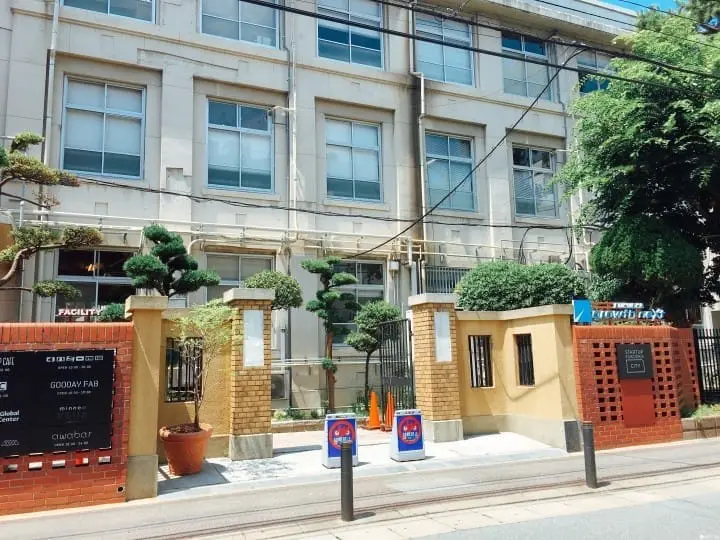
Startup Cafe is located near the Tenjin and Daimyo shopping districts, set up in the former Daimyo Elementary School.

The concept behind Startup Cafe is to assist individuals who want to start their own businesses and provide a platform for communication and networking for entrepreneurs.

Since the primary demographic visiting the Tenjin and Daimyo shopping districts consists of people in their 20s to 30s, it has attracted many restaurants catering to this age group. For example, Honey Coffee, shown above, is one of Fukuoka's popular cafes!
Cafe Yu Fukuoka Tenjin

Cafe Yu Fukuoka Tenjin is a soothing cafe that also functions as a pottery classroom. Just looking at the cafe's exterior makes you want to step inside and explore!

Upon entering the cafe through the glass sliding door, one feels a serene and peaceful atmosphere. The ceramic cups displayed on the open shelves are all handmade by staff, and customers can choose their cups from this selection.

Among the many cups, the most popular one at Cafe Yu is the unique bear-shaped ceramic cup. The latte art with a bear design to match the bear cup is absolutely adorable!
Ivorish

Ivorish (Japanese) is a popular French toast specialty shop located in the Daimyo shopping district. The exterior exudes a European atmosphere distinct from Japan.
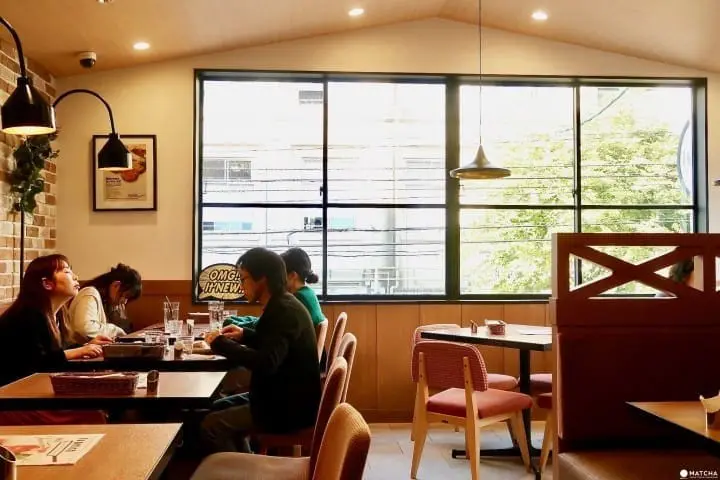
The first floor houses the ordering and bar seating area, while the second floor is the main seating area. Despite having limited seating, the simple interior design creates a relaxed and comfortable atmosphere.
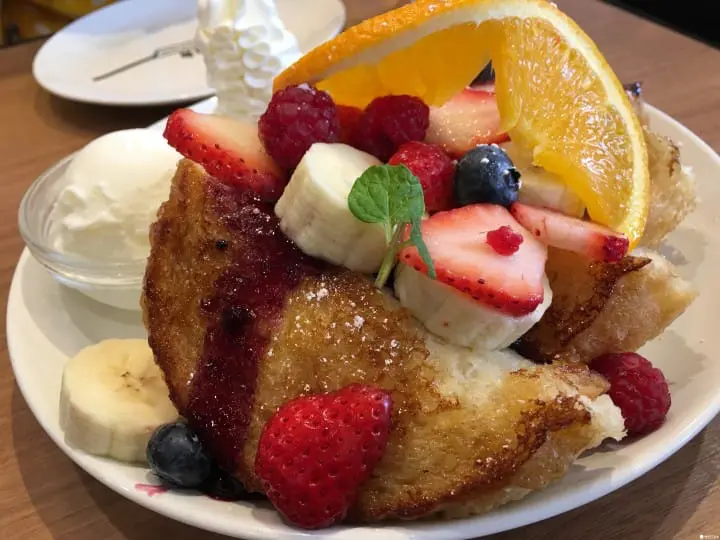
The outer layer of the French toast is crispy, while the inside is soaked in egg, presenting Ivorish's unique soft and fluffy texture. Pairing it with fresh fruit like bananas, strawberries, and blueberries adds variation and freshness to the texture, making it irresistible bite after bite.
Cha no Bunkan

Cha no Bunkan is located in Hoshino Village, Yame City, Fukuoka Prefecture. Yame is one of Kyushu's leading green tea-producing areas. It is known for its excellent stargazing due to its sparse population and lack of light pollution.
The central feature of the Tea Cultural Center is the Chakai Hall pictured, with its high ceiling creating a spacious feel. The square tables in the middle, accompanied by traditional Japanese red paper umbrellas, provide a cozy ambiance.

The Yame Tea Room in the cultural center has large floor-to-ceiling windows, making the dining area by the windows a special recommendation. Aside from the window-side seating area, there are also tatami mats and traditional Japanese room areas.

The must-order item is the Matcha Seidai! This super-rich matcha ice cream, paired with sweet red bean paste and matcha agar jelly, creates a refreshing and delicious taste that spreads instantly through your heart.
Tagashirachaho Daimyo Store

Tagashirachaho Daimyo Store is a new brand created by a Fukuoka tea shop with over 80 years of history. In addition to selling various Japanese tea leaves, its most appealing aspect is its matcha desserts.
The finest Uji and Yame teas are used, and the most popular item is the Matcha Seidai. Made with red bean paste, chestnuts, shiratama (white rice cake balls), matcha ice cream, and drizzled with matcha sauce, this rich combination in the Matcha Seidai is a dessert lover's dream! Available for dine-in or takeout.
Ito King Tenjin Store
Ito King Tenjin Store is a strawberry dessert specialty shop with its own "Ito King Tenjin Store Farm," where it cultivates and develops strawberry varieties.

Located in Tenjin, the shop has a retail area on the first floor and a dining area on the second floor. Their most popular item is the signature strawberry dorayaki, which has five layers of soft pancakes filled with rich white cream, strawberry cream, fresh strawberry sauce, and red bean paste.
The products do not contain unnecessary additives, allowing you to savor the authentic taste of strawberries year-round without waiting for strawberry season! Price: 390 yen per piece.
Check Fukuoka Accommodation Deals and Availability
Tsuzuri Cafe

Tsuzuri Cafe is located on the 3rd floor of Hakata Station Marui Department Store, one of the emerging popular cafes in Fukuoka in recent years. With a wooden atmosphere and several English-style hand-drawn paintings on the walls, the casual ambiance provides shoppers with the most relaxing place to take a break.
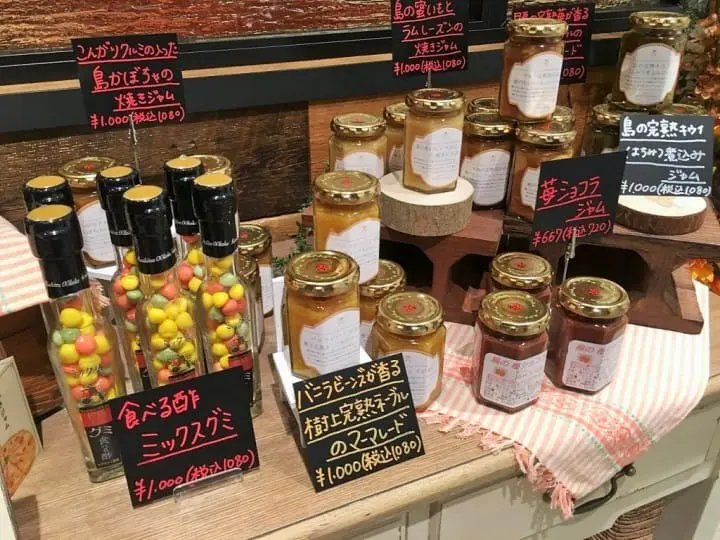
The cafe also sells its brand of vinegar, jam, and other products with charming packaging you would want to take home!

In addition to salads, pasta, and sandwiches, they also offer top-notch desserts. Their sizzling French mango pancakes, with a visually appealing presentation and the aroma of mango sauce on the hot plate, stimulate diners' auditory and gustatory senses!
Tea House Warabino

Tea House Warabino is located in the outskirts of Shinjuku, Fukuoka, a dining spot perfect for a drive-out excursion.
The entire building has open windows, offering a panoramic view of the surrounding scenery. The first floor serves as the main dining area, featuring a spacious, high-ceilinged dining space that enhances the dining experience.

After finishing your main meal, the staff will guide you to the second floor. On the way up, you can enjoy the floating piano performance in mid-air.

The second floor mostly features a cozy two-person sofa seating, where you can enjoy a relaxing afternoon leisurely.

Exquisite desserts paired with the breathtaking view outside and serene atmosphere inside create a romantic and secluded spot reminiscent of a hilltop hideaway, making it a favorite choice among locals for a date in Fukuoka.
Eating While Walking Makes Food Taste Better! Take-Out Food List
If you don't have time to sit down and rest, try these desserts that you can enjoy on the go. In addition to snacks, they embody many aspects of Japan's rich culinary culture!
Umegae Mochi

Originating from Dazaifu City in Fukuoka, this traditional sweet snack can be commonly found along the approach to Dazaifu Tenmangu Shrine.

Although named Umegae Mochi, this sweet treat does not contain plum or plum blossoms but uses red bean paste. The reason for its name, Umegae Mochi, is linked to the life story of Sugawara no Michizane, a renowned scholar and deity in Japan who is enshrined at Dazaifu Tenmangu Shrine.
When Michizane was exiled to Dazaifu, a region known for its abundant plum blossoms, local women took pity on him for his challenging circumstances and began wrapping millet cakes with plum branches to feed him. After Michizane's passing, the dessert was later created following this story to honor his memory, inventing the Umegae Mochi treat.
Taihoraku


What! Are there distinctions between "natural" and "farmed" taiyakis? Yes, in the case of "farmed" taiyaki, they are made using a long grill pan that can bake six to 10 at a time, while "natural" taiyaki uses a specially designed hand-grilled pan that can only bake up to two at a time.
Due to the inability of the natural grilling method to be mass-produced and the heavy labor costs involved, many emerging taiyaki shops have switched to the farmed grilling method for mass production. Only those shops aiming to create crispy-topped taiyaki insist on using the natural grilling method.

Taihakuraku is one of the establishments that insist on using the natural hand-grilled method, creating a crispy, thin pastry that bursts with filling when torn open, truly emphasizing quality!

Hakata Warabi Mochi
Hakata Warabi Mochi is a mobile vendor specializing in traditional Japanese sweets. To taste their craftsmanship, you must follow the vendor's Twitter to keep track of their locations.
This is a hidden gem in Fukuoka that you can't easily find without being informed! The vendor's bell-ringing sales pitch often quickly attracts passersby to stop and make a purchase.

What is warabi mochi? This traditional Japanese sweet is made from bracken starch, sugar, and water. After being molded into mochi, it is coated with soybean flour and drizzled with syrup or black sugar molasses.
While you can find warabi mochi in Japanese convenience stores, handmade versions like the ones from Hakata Ichiban Taiko Warabi Mochi surpass machine-made varieties in chewiness and sweetness from the black sugar molasses.
Visit Unique Bars to Sample Appetizers and Interact with Travelers
In recent years, unique bars in Fukuoka City have been popping up like mushrooms after the rain. Some bars offer food and drinks and provide accommodations for patrons to sleep after drinking alcoholic beverages.
Others are located in regular apartments, creating a unique atmosphere of tranquility amidst the bustle. Regardless of their setup, the biggest charm of these bars lies in the ability to interact with other bar-goers.
Stand by Me

Stand by Me offers a budget-friendly environment where you can enjoy drinks and mingle with global travelers from morning to night. Anyone can relax, chat, and have a hearty meal without breaking the bank!

One of the bar's most popular dishes is Japanese-style fried chicken nuggets. With their crispy exterior and juicy chicken meat, a squeeze of lemon adds a refreshing touch. The golden and smooth fried tofu also offers an irresistible, delicate pudding-like texture.
Bar Minna no Ko-Chan

Bar Minna no Ko-Chan is concealed within the Flat Kego building near Fukuoka's Maizuru Park. This apartment houses eight unique stores, including dessert shops, bookstores with illustrations, restaurants, and bars. It is one of the hottest hidden spots in Fukuoka!
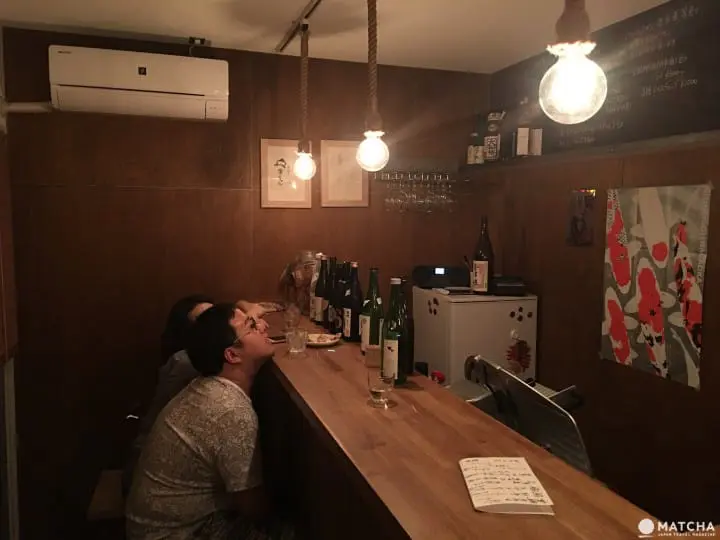
Originally from Kanagawa, the shop owner relocated to Fukuoka after leaving a job in Tokyo to pursue a career in the food and beverage industry. In 2016, he established his secret small bar.
Enjoy Fukuoka's Cuisine!

When mentioning "Fukuoka" to any Japanese friend, you'll likely see widened eyes and a thumbs up while they exclaim, "It's a culinary capital!"
The unique geography of Kyushu, surrounded by the sea, has indirectly influenced the city's culinary habits in Fukuoka. Dishes like beef intestine hot pot and mizutaki chicken hot pot, as well as a street food culture reminiscent of Taiwan's night markets, have emerged.
Following the culinary map provided by MATCHA editors, you'll likely fall in love with this culinary capital!
This account is managed by MATCHA. We aim to provide useful information to our readers in an enjoyable manner.

























































![[2026] Family Winter Trip to Suzuka Circuit! – For Both Day trips and Overnight Stays!](https://resources.matcha-jp.com/resize/720x2000/2025/12/26-254097.webp)
![[Northern Okinawa] 4 Recommended Cosmos Fields in Okinawa | Sunflowers and Cherry Blossoms in the Same Season!](https://resources.matcha-jp.com/resize/720x2000/2024/08/12-192028.webp)


